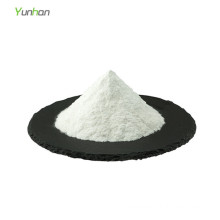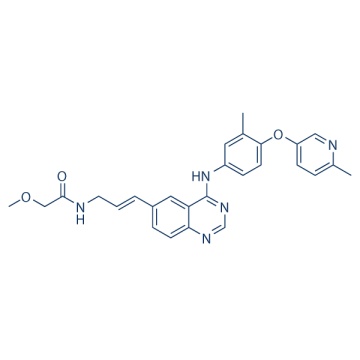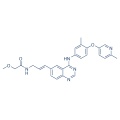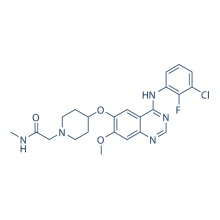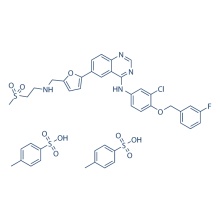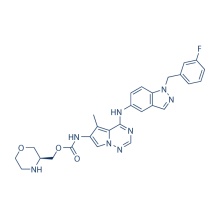CP-724714 537705-08-1
Product Description
.cp_wz table {border-top: 1px solid #ccc;border-left:1px solid #ccc; } .cp_wz table td{border-right: 1px solid #ccc; border-bottom: 1px solid #ccc; padding: 5px 0px 0px 5px;} .cp_wz table th {border-right: 1px solid #ccc;border-bottom: 1px solid #ccc; padding: 5px 0px 0px 5px;}
Molecular Weight:
469.53 CP-724,714 is a potent, selective inhibitor of HER2/ErbB2 with IC50 of 10 nM, >640-fold selectivity against EGFR, InsR, IRG-1R, PDGFR, VEGFR2, Abl, Src, c-Met etc. Phase 2.
Biological Activity
CP-724,714 is marked selectively against EGFR with IC50 of 6.4 μM.
CP-724,714 is >1,000-fold less potent for IR, IGF-1R, PDGFRβ, VGFR2,
abl. Src, c-Met c-jun NH2-terminal kinase (JNK)-2, JNK-3, ZAP-70,
cyclin-dependent kinase (CDK)-2, and CDK-5. CP-724,714 potently reduces
the EGF-induced autophosphorylation of the chimera containing the erbB2
kinase domain with IC50 of 32 nM, but is markedly less potent against
EGFR in transfected NIH3T3 cells. CP-724,714 sensitively inhibits the
proliferation of erbB2-amplified cells including BT-474 and SKBR3, with
IC50 of 0.25 and 0.95 μM.
CP-724,714 induces the accumulation of cells
in G1 phase and a marked reduction in S-phase in BT-474 cells at 1 μM. CP-724,714 likely exerts its hepatotoxicity via both hepatocellular
injury and hepatobiliary cholestatic mechanisms. CP-724,714 displays
inhibition of cholyl-lysyl fluorescein and taurocholate (TC) efflux into
canaliculi in cryopreserved and fresh cultured human hepatocytes,
respectively. CP-724,714 inhibits TC transport in membrane vesicles
expressing human bile salt export pump with IC50 of 16 μM and inhibits
the major efflux transporter in bile canaliculi, MDR1, with IC50 of ~28
μM.
CP-724,714 (25 mg/kg) is rapidly absorbed after p.o. administration and
causes reduction of tumor erbB2 receptor phosphorylation after dosing in
FRE-erbB2 or BT-474 xenografts. CP-724,714 induces Apoptosis in
FRE-erbB2 xenograft–bearing (s.c.) mice and shows 50% tumor growth
inhibition at 50 mg/kg, without weight loss or mortality. CP-724,714
also has great antitumor activity in MDA-MB-453, MDA-MB-231, LoVo
(colon), and Colo-205 (colon) xenografts. Furthermore, CP-724,714 (30 or
100 mg/kg) reduces the extracellular signal–regulated kinase and Akt
phosphorylation in BT-474 xenografts.
Kinase assays
Recombinant erbB2 (amino acid residues 675-1255) and EGFR (amino acid
residues 668-1211) intracellular domains are expressed in
baculovirus-infected Sf9 cells as glutathione S-transferase fusion
Proteins. The proteins are purified by affinity chromatography on
glutathione Sepharose beads for use in the assay. Nunc MaxiSorp 96-well
plates are coated by incubation overnight at 37 °C with 100 μL/well of
0.25 mg/mL poly(Glu:Tyr, 4:1), PGT in PBS. Excess PGT is removed by
aspiration and the plate is washed 3 times with wash buffer (0.1% Tween
20 in PBS).
The kinase reaction is performed in 50 μL of 50 mm HEPES (pH
7.4) containing 125 mm sodium chloride, 10 mm magnesium chloride, 0.1
mm sodium orthovanadate, 1 mm ATP, and ∼15 ng of recombinant protein.
Inhibitors in DMSO are added; the final DMSO concentration is 2.5%.
Phosphorylation is initiated by addition of ATP and proceeded for 6 min
at room temperature, with constant shaking.
The kinase reaction is
terminated by aspiration of the reaction mixture and washing four times
with wash buffer. Phosphorylated PGT is measured after a 25-min
incubation with 50 μL/well HRP conjugated-PY54 antiphosphotyrosine
antibody, diluted to 0.2 μg/mL in blocking buffer (3% BSA, 0.05% Tween
20 in PBS). Antibody is removed by aspiration and the plate is washed
four times with wash buffer.
The colorimetric signal is developed by
addition of 50 μL/well Tetramethylbenzidine Microwell Peroxidase
Substrate and stopped by the addition of 50 μL/well 0.09 m sulfuric
acid. The phosphotyrosine product formed is estimated by measurement of
absorbance at 450 nm. The signal for controls is typically A0.6–1.2,
with essentially no background in wells without ATP, kinase protein, or
PGT, and is proportional to the time of incubation for 6 min.
Method
Cells are seeded in duplicate at 5~10 × 103 per well in
24-well plates. The day after plating, CP-724,714 is added by titrating
over six or more dilutions from 0.1 nM to 10 μM. Control wells without
CP-724,714 are seeded as well. Cells are grown for 6 to 7 days, at which
time surviving cells are counted.
After trypsinization, cells are
placed in isotone solution and counted immediately using a Coulter Z2
particle counter. Growth inhibition is calculated [(1− experimental
value / control value) × 100] for each concentration. Dose-response
curves are repeated at least twice and averaged. IC50 values are
calculated using Calcusyn Software.
Contact us if you need more details on 537705-08-1. We are ready to answer your questions on packaging, logistics, certification or any other aspects about CP-724714 537705-08-1、537705-08-1 CP-724714. If these products fail to match your need, please contact us and we would like to provide relevant information.
Molecular Weight:
469.53 CP-724,714 is a potent, selective inhibitor of HER2/ErbB2 with IC50 of 10 nM, >640-fold selectivity against EGFR, InsR, IRG-1R, PDGFR, VEGFR2, Abl, Src, c-Met etc. Phase 2.
Biological Activity
CP-724,714 is marked selectively against EGFR with IC50 of 6.4 μM.
CP-724,714 is >1,000-fold less potent for IR, IGF-1R, PDGFRβ, VGFR2,
abl. Src, c-Met c-jun NH2-terminal kinase (JNK)-2, JNK-3, ZAP-70,
cyclin-dependent kinase (CDK)-2, and CDK-5. CP-724,714 potently reduces
the EGF-induced autophosphorylation of the chimera containing the erbB2
kinase domain with IC50 of 32 nM, but is markedly less potent against
EGFR in transfected NIH3T3 cells. CP-724,714 sensitively inhibits the
proliferation of erbB2-amplified cells including BT-474 and SKBR3, with
IC50 of 0.25 and 0.95 μM.
CP-724,714 induces the accumulation of cells
in G1 phase and a marked reduction in S-phase in BT-474 cells at 1 μM. CP-724,714 likely exerts its hepatotoxicity via both hepatocellular
injury and hepatobiliary cholestatic mechanisms. CP-724,714 displays
inhibition of cholyl-lysyl fluorescein and taurocholate (TC) efflux into
canaliculi in cryopreserved and fresh cultured human hepatocytes,
respectively. CP-724,714 inhibits TC transport in membrane vesicles
expressing human bile salt export pump with IC50 of 16 μM and inhibits
the major efflux transporter in bile canaliculi, MDR1, with IC50 of ~28
μM.
CP-724,714 (25 mg/kg) is rapidly absorbed after p.o. administration and
causes reduction of tumor erbB2 receptor phosphorylation after dosing in
FRE-erbB2 or BT-474 xenografts. CP-724,714 induces Apoptosis in
FRE-erbB2 xenograft–bearing (s.c.) mice and shows 50% tumor growth
inhibition at 50 mg/kg, without weight loss or mortality. CP-724,714
also has great antitumor activity in MDA-MB-453, MDA-MB-231, LoVo
(colon), and Colo-205 (colon) xenografts. Furthermore, CP-724,714 (30 or
100 mg/kg) reduces the extracellular signal–regulated kinase and Akt
phosphorylation in BT-474 xenografts.
Kinase assays
Recombinant erbB2 (amino acid residues 675-1255) and EGFR (amino acid
residues 668-1211) intracellular domains are expressed in
baculovirus-infected Sf9 cells as glutathione S-transferase fusion
Proteins. The proteins are purified by affinity chromatography on
glutathione Sepharose beads for use in the assay. Nunc MaxiSorp 96-well
plates are coated by incubation overnight at 37 °C with 100 μL/well of
0.25 mg/mL poly(Glu:Tyr, 4:1), PGT in PBS. Excess PGT is removed by
aspiration and the plate is washed 3 times with wash buffer (0.1% Tween
20 in PBS).
The kinase reaction is performed in 50 μL of 50 mm HEPES (pH
7.4) containing 125 mm sodium chloride, 10 mm magnesium chloride, 0.1
mm sodium orthovanadate, 1 mm ATP, and ∼15 ng of recombinant protein.
Inhibitors in DMSO are added; the final DMSO concentration is 2.5%.
Phosphorylation is initiated by addition of ATP and proceeded for 6 min
at room temperature, with constant shaking.
The kinase reaction is
terminated by aspiration of the reaction mixture and washing four times
with wash buffer. Phosphorylated PGT is measured after a 25-min
incubation with 50 μL/well HRP conjugated-PY54 antiphosphotyrosine
antibody, diluted to 0.2 μg/mL in blocking buffer (3% BSA, 0.05% Tween
20 in PBS). Antibody is removed by aspiration and the plate is washed
four times with wash buffer.
The colorimetric signal is developed by
addition of 50 μL/well Tetramethylbenzidine Microwell Peroxidase
Substrate and stopped by the addition of 50 μL/well 0.09 m sulfuric
acid. The phosphotyrosine product formed is estimated by measurement of
absorbance at 450 nm. The signal for controls is typically A0.6–1.2,
with essentially no background in wells without ATP, kinase protein, or
PGT, and is proportional to the time of incubation for 6 min.
Method
Cells are seeded in duplicate at 5~10 × 103 per well in
24-well plates. The day after plating, CP-724,714 is added by titrating
over six or more dilutions from 0.1 nM to 10 μM. Control wells without
CP-724,714 are seeded as well. Cells are grown for 6 to 7 days, at which
time surviving cells are counted.
After trypsinization, cells are
placed in isotone solution and counted immediately using a Coulter Z2
particle counter. Growth inhibition is calculated [(1− experimental
value / control value) × 100] for each concentration. Dose-response
curves are repeated at least twice and averaged. IC50 values are
calculated using Calcusyn Software.
Contact us if you need more details on 537705-08-1. We are ready to answer your questions on packaging, logistics, certification or any other aspects about CP-724714 537705-08-1、537705-08-1 CP-724714. If these products fail to match your need, please contact us and we would like to provide relevant information.
Product Categories : Protein Tyrosine Kinase > HER2 Inhibitor
Other Products
Hot Products
Astragaloside AChlortetracycline HCl 64-72-2Paclitaxel 33069-62-4Dexamethasone Acetate 1177-87-3Dinaciclib (SCH727965) 779353-01-4CHIR-124 405168-58-3Ro3280 1062243-51-9TAME 901-47-3CCG-1423 285986-88-110058-F4 403811-55-2Dabigatran (BIBR 953) 211914-51-1H 89 2HCl 130964-39-5T0901317 293754-55-9Aprepitant 170729-80-3Turofexorate Isopropyl (XL335) 629664-81-9BMS-378806 357263-13-9








